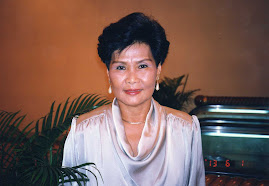
Today at 10:00am in Parkview, Johannesburg at the
Soka Gakkai cultural centre, we were 21-strong to remember Margie ...
The Master of Ceremonies, Loren Braithwaite Kabosha, and her team led us through the 40-minute service which started with the chanting of daimoku - a 15-minute chant of
Nam-myoho-renge-kyo meaning superficially in English ...
I devote my life to the mystic law of cause and effect, revealed in the Buddhist teachings, which permeates the entire universe.
It’s difficult to logically explain the effect of the sound of
Nam-myoho-renge kyo, but by chanting
Nam-myoho-renge-kyo, we created the sound of Buddhahood. Hearing that sound drew out our own enlightened life state and, for a brief moment, we experienced its power.
We chanted to a mandala, or Gohonzon, which represented our enlightenment. The Gohonzon is the embodiment of the Law of Nam-myoho-renge-kyo in the form of a mandala.
Honzon means ‘object of fundamental respect’;
go means ‘worthy of honour’. The Gohonzon took the form of a paper scroll inscribed with Chinese and Sanskrit characters in black sumi ink.
Adam Lai conducted the Gongyo and the daimoku continued until everyone had a chance to offer his or her prayers to Margie given with a piece of incense placed on a burning ember ...
... and then followed the eulogy by Charles which touched on Margie's great gift for making friends because of the travelling from Charles work, how she learned golf which encouraged her sons to play, how she taught her friends mah jong, how she cooked wonderful Chinese and Western food and how she was the life and soul of every group she belonged to.
... and Loren summed up by remarking how much loved she had been by her family and friends and that Margie is and will be looking out for us all ... eternally ... and then some final words from Nichiren Daishonin read by Loren with a beautiful metaphor of our lives as the ocean with our life starting off as a wave, distinguishable and separate, and our death seen as the wave breaking and being absorbed back into the sea ... an eternal ocean of waves coming and going (see full texts below).
[ a picture of us to come]
Colin, Tembe, Keke, Lizzie, Nombeko, Julie, Andre, Frieda, Heather, Shirley and Chris and their friend Isabel, Laura and Trevor plus Loren (SGI leader), Adam, ?, ?, ? and the little one ? ... and Sam the caretaker.
In memory of Nooi - "the little one" ... a slideshow of her life was watched by all.
.............
Full texts read by Loren:
1. Dialogue on the Lotus Sutra #35
Ikeda: The second Soka Gakkai president, Josei Toda, would often say that upon death our lives fuse with the universe. It's not a matter of there being a soul; rather, our life, as an entity of the oneness of body and mind, returns to the universe. The universe itself is one great living entity. It is a vast ocean of life. It nurtures all things, gives all things life and enables them to function. When things die, they return again to its embrace and receive new vitality. There is a boundless and overflowing ocean of life, which is always in motion. As it moves and changes, it enacts the rhythm of life and death. Our individual lives are like waves produced from the great ocean that is the universe; the emergence of a wave is "life," and its abatement is "death." This rhythm repeats eternally. This is not only true of the lives of people. Nichiren Daishonin says, "No phenomena - heaven or earth, Yin or Yang, the sun or the moon, the five planets, or any life-condition from Hell to Buddhahood - are free from birth and death" (The Major Writings of Nichiren Daishonin, vol. 1, pp. 21-22). "Heaven or earth, Yin or Yang, the sun or the moon, the five planets" refers to the realm of celestial bodies. Stars also experience birth and death. They have a life span. The Milky Way was born and it, too, will die; its life is limited. The laws of birth and death dictate this. The same holds true in the realm of the microscopic. Each of the Ten Worlds from Hell to Buddhahood, in all phenomena, experiences birth and death. For example, the state of Hell may manifest in life at one time, and in death at another. The Daishonin writes to his follower Nanjo Tokimitsu about his late father, "While he was in this world, he was a living Buddha, and now, he is a Buddha in death. His Buddhahood transcends both life and death" (MW-2 [2nd ed.], 207), indicating that the effect of Buddhahood he had attained in his life would continue even after death.
2. An extract from a book entitled Buddhism in Action, Volume VI, which is a collection of the speeches of our international president Daisaku Ikeda, entitled "The Privelege of Believers".
(link to come)


 Today at 10:00am in Parkview, Johannesburg at the Soka Gakkai cultural centre, we were 21-strong to remember Margie ...
Today at 10:00am in Parkview, Johannesburg at the Soka Gakkai cultural centre, we were 21-strong to remember Margie ...